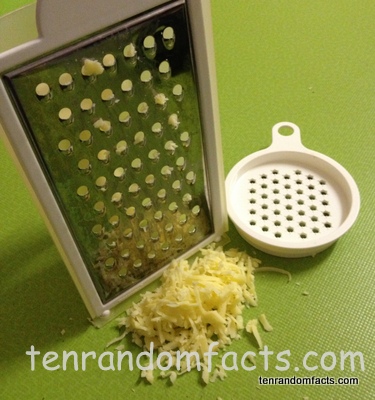Grate the cheese.
- A grater is also known as a shredder, and by pressing the food against the grater and moving the food down along it, it shreds the food into smaller pieces.
- Graters come in a wide variety of shapes and styles, including the traditional box grater, and the plane grater, although most have a steel plate with sharp edged holes.
- It is believed that French François Boullier invented the grater in the 1540s, due to a surplus supply of cheese, although the surplus was short lived, and so graters were very rarely used in the following centuries.
- Due to the significant excess of cheese in the early 1500s, much of the cheese hardened due to longer storage times, so grating the cheese made it more usable.
- Graters can cut fingers or knuckles if you strike your hand on one, so care needs to be taken while grating.
- Coconut graters are used as musical instruments in Jamaica.
- The first grater was made out of pewter, a type of metal mainly made of tin, and can be seen in the Muséum du Havre in France.
- Graters were reintroduced in the 1920s by Jeffery Taylor from Philadelphia, a cheese shop owner, after he read about Boullier’s invention, and his first grater was said to be a sharpened metal shower drain.
- Cheese; some vegetables; citrus rinds; chocolate; and other hard, or semi hard foods can be grated, which allows them to cook or melt more quickly, or they can be used as a garnish.
- Graters became popular in the Great Depression because grated cheese appeared to have greater volume, which was an advantage to those who could not afford large quantities of food.





